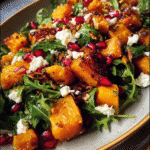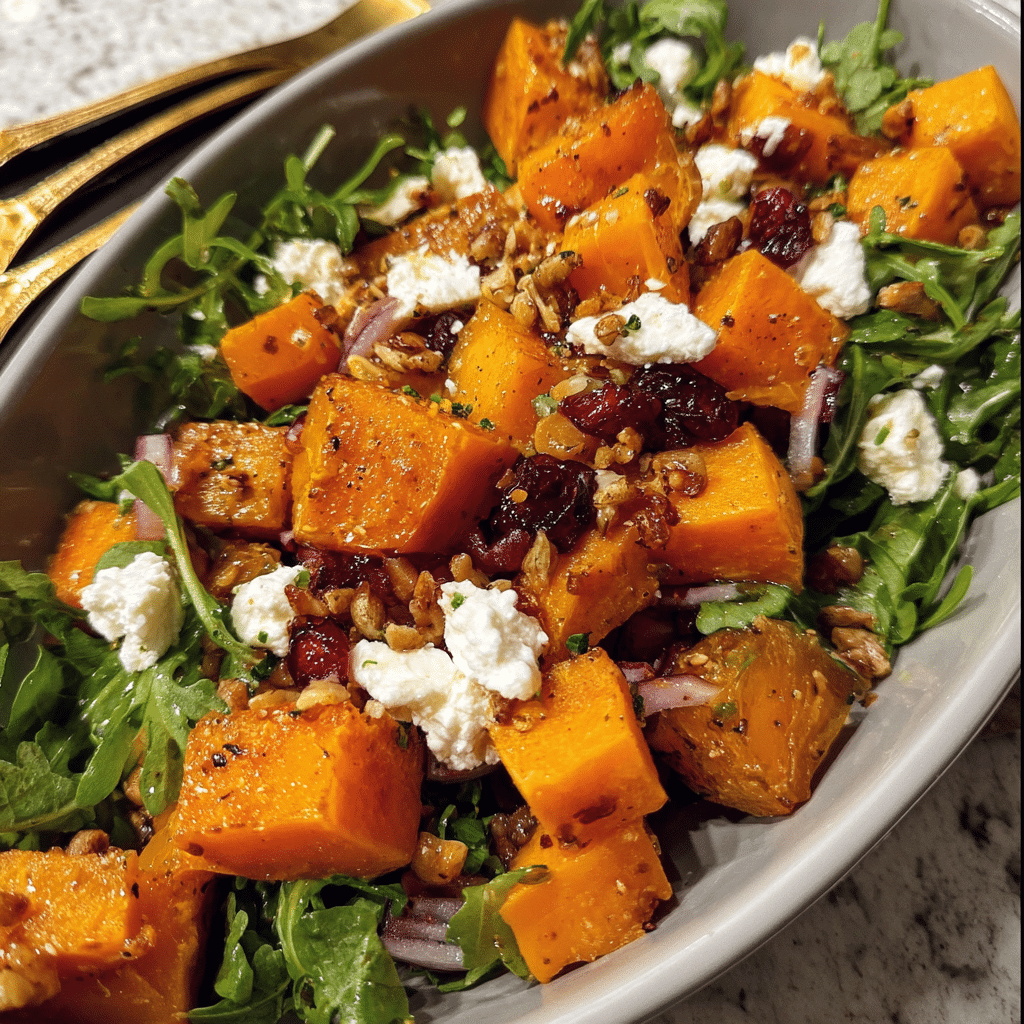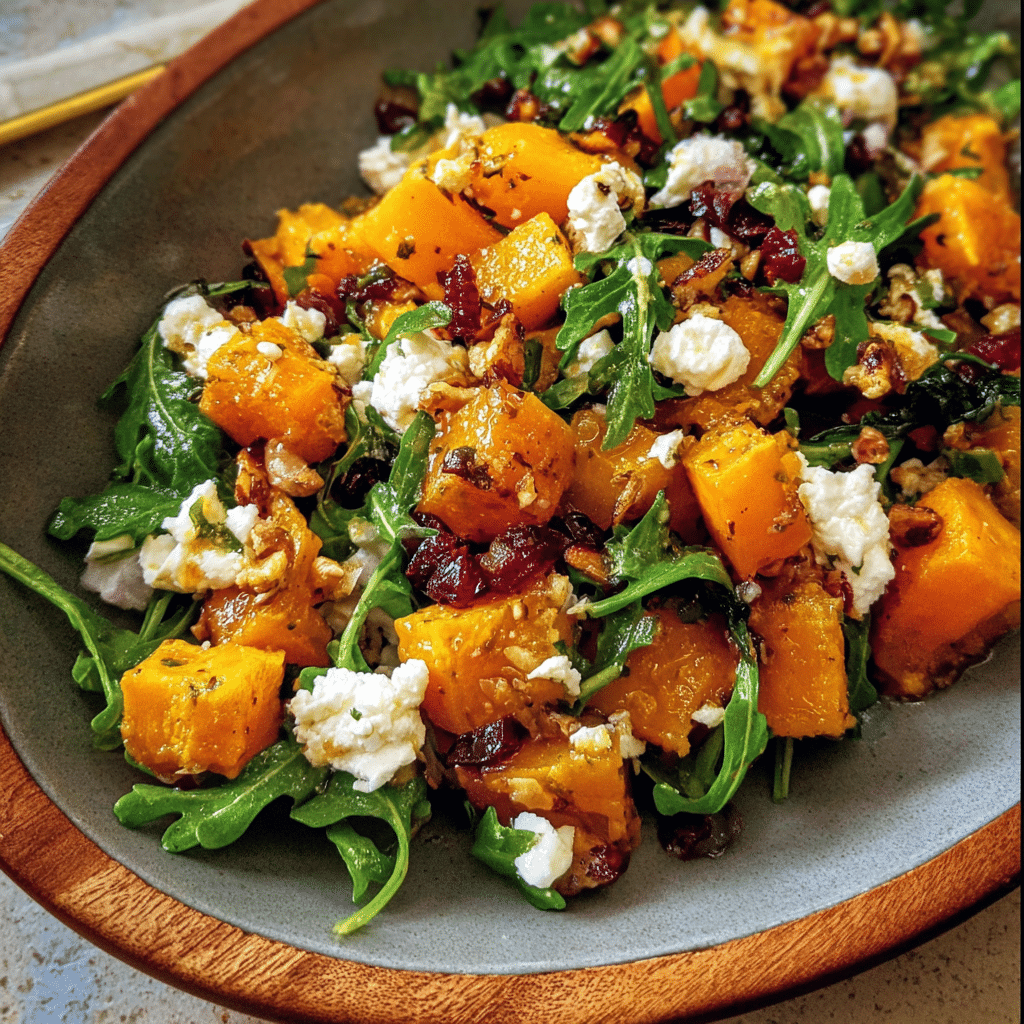Butternut squash feta is more than just a delightful combination of flavors; it’s a dish steeped in personal memories and culinary exploration. I remember the first time I stumbled upon this vibrant salad at a local farmer’s market. It was autumn, and the air was crisp, filled with the earthy scent of roasted squash mingling with the sweetness of apples and the tang of feta cheese. I was drawn to a stall adorned with bright orange and yellow hues, where a cheerful vendor was offering samples of his famous butternut squash feta salad. The moment that first bite hit my palate, I was hooked. The creamy feta crumbled over the sweet, tender squash was a textural delight that instantly transported me back to family dinners during the fall season.

As I stood there, savoring the salad, I realized how this dish encapsulated the essence of autumn — warm, hearty, and comforting. In that moment, I decided I had to recreate this salad at home, adding my own twist to it. Little did I know that this simple recipe would become a staple in my kitchen, often served during family gatherings, holiday dinners, and even as a quick weeknight meal. The beauty of butternut squash feta is that it strikes the perfect balance between indulgence and health, making it an ideal option for busy families looking for quick dinner solutions.
The Story Behind This Recipe
The origins of butternut squash feta go beyond a singular recipe; they reflect a cultural tapestry that celebrates the harvest season. Traditionally, butternut squash has been a beloved ingredient in many cuisines, particularly in North America where it thrives in the cooler months. Feta, a brined cheese that hails from Greece, adds a creamy, salty contrast that enhances the natural sweetness of the squash. This combination of ingredients showcases how cultures can blend culinary practices to create something truly unique.
What makes butternut squash feta so special is its adaptability. While the core ingredients remain the same, you can easily switch things up based on what you have on hand or what’s in season. Adding nuts for crunch, a splash of balsamic vinegar for acidity, or fresh herbs for brightness can transform this dish from a simple salad to a gourmet experience. This versatility is particularly appealing for families who often need to accommodate various tastes and dietary restrictions.
As the seasons change, butternut squash feta becomes a symbol of autumnal abundance. It’s the perfect dish to prepare during this time, as butternut squash is in peak season from September to December. In our home, we look forward to making this salad as the leaves start to turn, filling our kitchen with the warm, inviting aroma of roasted vegetables. The emotional connection to the dish runs deep; it reminds us of cozy dinners spent around the table, sharing stories and laughter, and creating lasting memories.
In this guide, you’ll learn not only how to make a classic butternut squash feta salad but also how to adapt it to suit your family’s preferences. Whether you’re looking for a quick weeknight meal or an impressive dish to serve at your next gathering, this recipe will become a favorite in your culinary repertoire. So, let’s dive into the world of butternut squash feta and explore its rich flavors and delightful possibilities!
The Rich History and Cultural Significance of butternut squash feta
The rich history and cultural significance of butternut squash feta extend far beyond its delectable flavor profile. The story of this dish is intertwined with the agricultural heritage of squash cultivation and the culinary traditions surrounding cheese-making. Originating from the Americas, butternut squash is believed to have been cultivated by indigenous peoples for thousands of years. Its sweet, nutty flavor and versatility made it a staple food, often used in soups, stews, and roasted dishes.
Origins and History
Butternut squash is a member of the gourd family and is classified as a winter squash. It was first developed in the 1940s by a Massachusetts farmer named Charles Leggett, who sought to create an easier-to-harvest variety of squash. This new cultivar quickly gained popularity and has since become a beloved ingredient in kitchens around the world. The sweet, dense flesh of butternut squash pairs beautifully with a variety of ingredients, making it a versatile option for both savory and sweet dishes.
On the other hand, feta cheese has a storied past that dates back to ancient Greece. Made primarily from sheep’s milk, feta has been produced for thousands of years and is often associated with Mediterranean cuisine. Its crumbly texture and tangy flavor make it an excellent complement to roasted vegetables, salads, and grains. The combination of butternut squash and feta is a perfect example of how culinary traditions can evolve and adapt, bringing together ingredients from different cultures to create something truly special.
Cultural Significance
In many cultures, squash is not just a food item but also a symbol of abundance and harvest. Festivals celebrating the autumn harvest often feature dishes that highlight seasonal produce, including butternut squash. In Greece, feta cheese is integral to many traditional dishes and is often served alongside roasted vegetables or as part of a mezze platter. The marriage of butternut squash and feta in a salad creates a dish that embodies the spirit of sharing and community, making it a popular choice for family gatherings and festive occasions.
Over the years, the butternut squash feta salad has evolved, with chefs and home cooks alike experimenting with different flavor combinations. From adding grains like quinoa or farro to incorporating dried fruits such as cranberries or pomegranate seeds, this dish has become a canvas for culinary creativity. Renowned chefs have also embraced this combination, often showcasing it in upscale restaurants as a seasonal offering.
Nutritional Benefits
Beyond its rich flavors and cultural significance, butternut squash feta salad is a nutritional powerhouse. Butternut squash is low in calories and packed with vitamins A and C, making it an excellent choice for those looking to boost their immune system and support skin health. It’s also a good source of fiber, which aids digestion and promotes a feeling of fullness.
The feta cheese adds a dose of calcium and protein, making this salad not only satisfying but also beneficial for bone health. Furthermore, the addition of fresh greens, nuts, or seeds can enhance the nutritional profile, providing healthy fats and additional vitamins. This makes butternut squash feta a smart choice for families aiming to eat well without sacrificing flavor.
As we explore the depths of butternut squash feta, it’s clear that this dish is more than just a salad; it’s a celebration of culture, history, and the joy of sharing good food with loved ones. So join me on this culinary journey as we uncover the myriad ways to enjoy this delightful dish!
Essential Ingredients for Perfect butternut squash feta
When it comes to creating a dazzling butternut squash feta salad, the foundation lies in choosing the right ingredients. Each element plays a crucial role, not only in flavor but also in texture and nutrition. Let’s dive into the essential ingredients that will help you craft this vibrant and delicious salad.
Essential Ingredients
- 1 medium butternut squash (about 2-3 pounds): The star of our dish, the butternut squash, provides a sweet, nutty flavor and creamy texture once roasted. Look for a squash that feels heavy for its size and has a smooth, unblemished skin.
- 4 ounces feta cheese: Feta adds a tangy creaminess that balances the sweetness of the squash. Opt for high-quality, crumbly feta, preferably made from sheep’s milk, for a more robust flavor.
- 2 tablespoons olive oil: This is essential for roasting the squash, helping to enhance its natural sweetness and imparting a lovely richness. Choose extra virgin olive oil for the best flavor.
- 1 tablespoon balsamic vinegar: A drizzle of balsamic vinegar adds a sweet-tart note that complements the squash beautifully. Look for aged balsamic for deeper flavors.
- 1 teaspoon honey or maple syrup: A touch of sweetness enhances the overall flavor profile. Use local honey or pure maple syrup for the best results.
- Salt and pepper to taste: These simple seasonings elevate the dish, allowing the other flavors to shine. Freshly cracked black pepper is always best.
- Fresh herbs (such as parsley or sage): Adding a handful of fresh herbs not only brightens the salad but also adds a layer of complexity. Fresh parsley brings a pop of color, while sage complements the squash’s earthiness.
- Optional: nuts or seeds (such as walnuts or pumpkin seeds): For added crunch and nutrition, consider tossing in some nuts or seeds. They provide a delightful contrast to the creamy feta and soft squash.

Butternut Squash Feta Salad
Ingredients
For The Salad:
- 2 lbs. butternut squash cubed, equals 5-6 heaping cups
- 2 Tbsp. olive oil
- 1 tsp. smoked paprika
- 1 tsp. garlic powder
- ¼ tsp. kosher salt
- ¼ tsp. pepper
- 5 oz. hearty greens such as arugula, spinach, kale, or Swiss chard
- ¾ cup walnuts or nuts of choice
- ¾ cup feta cheese or cheese of choice
For The Dressing:
- 2 Tbsp. olive oil
- 2 Tbsp. lemon juice
- 1 Tbsp. Dijon mustard
- 1 Tbsp. maple syrup
- ¼ tsp. kosher salt
- pinch pepper
Instructions
- Heat oven to 400 degrees Fahrenheit.
- How To Peel and Cut The Butternut Squash:
- Remove the top and bottom of the squash with a sharp knife and discard in the compost or trash bin.
- Cut the butternut squash in half. Place each half, flat side down, on the cutting board. Carefully run the knife down the outer surface of each butternut squash half, or peel it with a vegetable peeler. Discard the skins in the compost or trash bin.
- Cut each half of the squash in half again. Scoop out the seeds and membranes from the bottom portion of the squash with a large spoon, just as you would a pumpkin. Discard the seeds and membranes.
- Cut each half of the squash into slices and then cut those slices into chunks. It’s important that the squash chunks are relatively the same size to ensure that they cook evenly.
- This recipe calls for 5-6 heaping cups of cubed butternut squash.
- For The Salad:
- Place the cubed butternut squash onto a large baking sheet. Drizzle 2 Tbsp. olive oil over the butternut squash and toss to coat. Alternately, you can spread the butternut squash out across two smaller baking sheets.
- Sprinkle 1 tsp. each smoked paprika and garlic powder, along with ¼ tsp. each kosher salt and pepper over the butternut squash. Toss until completely combined.
- Place the baking sheet in the oven and roast the butternut squash for 22-25 minutes, or until tender. Baking times may vary slightly.
- The squash should be tender, but not mushy, and easily pierced with a knife when done. Remove the pan when finished and set aside to cool.
- For The Dressing:
- Combine 2 Tbsp. olive oil, 2 Tbsp. lemon juice, 1 Tbsp. Dijon mustard, 1 Tbsp. maple syrup, ¼ tsp. kosher salt and a pinch of pepper in a small bowl.
- Whisk all of the ingredients together until combined using a small whisk or fork.
- For The Walnuts:
- Place a small cast iron skillet or small pan on the stove top. Pour ¾ cup of unsalted walnuts (or nuts of choice) into the pan.
- Heat to medium-low and toast the nuts for 5-6 minutes, stirring occasionally to prevent them from burning. Remove the pan from the heat after the walnuts are toasted.
- Assemble The Salad:
- Place 5 oz. of your favorite hearty greens (such as arugula, spinach, kale, or Swiss chard) in a large mixing bowl.
- Drizzle as much or as little of the dressing as you like over the salad and toss until completely coated.
- To Serve: Pour the dressed salad out onto a serving platter or into a large serving bowl. Place the cooled roasted butternut squash on top of the greens. Add the ¾ cup toasted walnuts and ¾ cup crumbled feta cheese on top of the salad.
Shopping Tips
When shopping for ingredients for your butternut squash feta salad, freshness is key. For the butternut squash, check for firmness and a matte finish, which indicates ripeness. Avoid squashes with soft spots or blemishes. Seasonal availability is also important; butternut squash is typically in season from late summer through fall, making autumn the perfect time to create this dish. You can often find them at local farmers’ markets or grocery stores during this time.
For feta, consider visiting local cheese shops or specialty markets where you can often find fresher options. If you’re going for pre-packaged feta, check the expiration date and opt for those stored in brine for better flavor and longevity.
Substitutions and Alternatives
Not everyone can enjoy every ingredient, and that’s perfectly fine! If you’re looking for substitutes for the butternut squash, consider sweet potatoes or pumpkin, both of which offer similar textures and flavors. For a dairy-free option, try using a vegan feta alternative made from nuts or tofu. If you’re watching your sugar intake, feel free to omit the honey or maple syrup entirely; the natural sweetness of the squash should suffice. Additionally, you can replace balsamic vinegar with apple cider vinegar for a different tangy kick.
When it comes to storage, keep any leftover butternut squash in an airtight container in the fridge for up to five days. Feta cheese should also be stored in the refrigerator, ideally submerged in its brine to maintain freshness. If you have leftover salad, it’s best to enjoy it fresh, but you can store it for a day, keeping in mind that the greens may wilt over time.
For those on a budget, butternut squash is often one of the more affordable seasonal vegetables. Buying in bulk or purchasing from local farms can save you money. Also, consider growing your own herbs if you have the space; they require minimal investment and can provide a constant supply for your culinary adventures.
By selecting high-quality ingredients and being mindful of substitutions, you’ll create a butternut squash feta salad that is not only delicious but also accommodates a variety of dietary needs and preferences.
Detailed Step-by-Step butternut squash feta Cooking Instructions
Creating a stunning butternut squash feta salad is a delightful experience that engages your senses from start to finish. This recipe is not only simple but also allows for creativity in presentation and flavor. Let’s break down the detailed step-by-step instructions to ensure your salad turns out perfectly every time.
Preparation Steps
- Gather your ingredients: Start by assembling all your ingredients on the counter. This mise en place technique will make your cooking process smoother and more efficient. Lay out your butternut squash, feta cheese, olive oil, balsamic vinegar, honey, salt, pepper, herbs, and any nuts or seeds you plan to use.
- Preheat your oven: Set your oven to 400°F (200°C). Preheating ensures your squash roasts evenly and develops that irresistible caramelization.
- Peel and cube the butternut squash: Carefully peel the squash using a vegetable peeler. Cut off both ends, then slice it in half and scoop out the seeds with a spoon. Cut the squash into small, uniform cubes (about 1-inch) to ensure even cooking. This step is crucial as it affects both the texture and cooking time.
- Season the squash: In a large mixing bowl, add your cubed butternut squash. Drizzle with olive oil, then sprinkle with salt and pepper. Toss until all pieces are well-coated. The oil not only helps with roasting but also enhances the flavor of the squash.
- Spread on a baking sheet: Line a baking sheet with parchment paper for easy clean-up. Spread the seasoned squash in a single layer, ensuring that they aren’t overcrowded. This allows for proper roasting, giving the squash a nice golden brown exterior.
Cooking Process
- Roast the squash: Place the baking sheet in the preheated oven and roast the squash for about 25-30 minutes. Stir halfway through to ensure even cooking. You’ll know it’s done when the squash is fork-tender and slightly caramelized. The aroma that fills your kitchen will be nothing short of heavenly!
- Prepare the dressing: While the squash is roasting, whisk together the balsamic vinegar and honey (or maple syrup) in a small bowl. This dressing will add a sweet-tart contrast that perfectly balances the dish. Taste and adjust the sweetness as desired.
- Chop the herbs: Finely chop your fresh herbs of choice. This step brings vibrant color and freshness to the salad. If you’re using sage, be sure to chop it finely, as its strong flavor can easily overpower the other ingredients.
- Check for doneness: Once the squash is roasted, take it out of the oven and let it cool slightly. This cooling period allows the flavors to meld better when mixed with the other ingredients.
Final Assembly
- Combine the ingredients: In a large serving bowl, combine the roasted butternut squash, crumbled feta cheese, chopped herbs, and nuts or seeds if using. Gently toss everything together, allowing the feta to slightly melt into the warm squash.
- Add the dressing: Drizzle the balsamic dressing over the salad and toss gently to coat all ingredients evenly. The warmth of the squash will help the dressing adhere beautifully.
- Taste and adjust: Before serving, do a quick taste test. Adjust the seasoning with more salt, pepper, or dressing if needed. This is your chance to make the salad perfect for your palate!
- Serve and enjoy: Transfer the salad to a beautiful serving platter or individual bowls. This dish can be served warm or at room temperature, making it versatile for any occasion, from a casual weeknight dinner to a festive gathering.
Common mistakes to avoid include overcrowding the baking sheet, which can lead to steaming rather than roasting, and neglecting to check for doneness. Trust your senses—look for golden edges and a sweet, nutty aroma. Remember, the butternut squash feta salad is not just about taste; it’s about the experience of creating something beautiful and delicious. Enjoy your cooking adventure!

Professional Tips and Techniques for butternut squash feta
When it comes to preparing a delicious butternut squash feta salad, there are some professional tips and techniques that can elevate your dish from good to spectacular. As a passionate food enthusiast, I’ve spent countless hours experimenting with various cooking methods and ingredients to create the perfect harmony of flavors. Let’s dive into the nuances of this delightful dish!
Professional Techniques
Starting with the butternut squash, the first step is to select the right squash. Look for ones that are heavy for their size, with a firm rind and a uniform beige color. Avoid any with blemishes or soft spots. When it comes to peeling and cutting, I find that using a sharp vegetable peeler works wonders. Butternut squash can be tough, so I recommend slicing off the top and bottom ends to create a stable base. Then, peel the skin with long strokes, and cut the squash in half lengthwise to scoop out the seeds.
Once your squash is prepared, the cooking method can greatly impact the final result. Roasting the butternut squash is my preferred method as it caramelizes the natural sugars, enhancing its sweetness. Preheat your oven to 425°F (220°C) and toss the cubed squash in olive oil, salt, and pepper. Spread it out in a single layer on a baking sheet and roast for about 25-30 minutes, or until golden brown and tender. For an added depth of flavor, consider sprinkling some smoked paprika or cinnamon before roasting.
As you combine the roasted butternut squash with feta cheese, remember that the cheese should be crumbled rather than grated. Crumbled feta provides a burst of flavor with each bite, while grated cheese tends to melt too easily and lose its character. Don’t forget to add fresh herbs like parsley or mint to brighten up the dish and add a touch of freshness.
Troubleshooting Guide
Even the most seasoned cooks can face challenges while preparing a butternut squash feta salad. One common issue is the squash being too watery, which can happen if it’s overcooked. To prevent this, keep an eye on the squash while roasting and check for doneness with a fork; it should be tender but not mushy. If you find that your salad is too watery after mixing in the dressing, a simple fix is to drain some of the excess moisture or add more crumbled feta to absorb it.
Another common problem is balancing flavors. The sweetness of butternut squash pairs beautifully with the tangy feta, but if your salad feels too sweet, consider adding a splash of balsamic vinegar or a squeeze of lemon juice to brighten the overall flavor. A pinch of salt can also help to enhance the taste without overpowering the dish.
Presentation Tips
Presentation is key when it comes to serving a butternut squash feta salad. I always strive to create a visually appealing dish that invites guests to dig in. Start by using a large, shallow bowl to showcase the vibrant colors of the roasted squash and fresh greens. Layer the ingredients artfully, beginning with a bed of mixed greens or arugula, followed by the roasted squash, and then generously sprinkle the feta on top.
For an added touch, consider garnishing with pomegranate seeds, which not only add a pop of color but also a delightful crunch. A drizzle of good-quality olive oil and a sprinkle of freshly cracked black pepper can elevate the presentation further. Remember, we eat with our eyes first, so don’t hesitate to get creative!
Make-Ahead and Meal Prep Strategies
If you’re planning a gathering or simply want to enjoy your butternut squash feta salad throughout the week, meal prepping can be a lifesaver. Roasted butternut squash can be stored in an airtight container in the refrigerator for up to five days. You can also prepare the dressing in advance; a simple olive oil and lemon vinaigrette pairs beautifully with the salad and can be stored in the fridge for up to a week.
When it comes to assembling your salad, keep the components separate until you’re ready to serve to maintain freshness. Combine the greens, add the roasted squash, and top with feta and dressing right before serving. This not only keeps the salad crisp but also allows you to enjoy the flavors at their best.
Scaling the Recipe
Whether you’re preparing a small meal for yourself or hosting a large gathering, scaling your butternut squash feta salad recipe is straightforward. For smaller portions, simply halve the quantities of each ingredient. For larger groups, you can multiply the ingredients accordingly, but be mindful of your roasting pan size. You may need to roast the squash in batches to ensure even cooking.
Wine and Beverage Pairings
Pairing beverages with your butternut squash feta salad can enhance the dining experience. A crisp, dry white wine, such as Sauvignon Blanc or Pinot Grigio, complements the sweetness of the squash while cutting through the richness of the feta. If you prefer red, a light-bodied Pinot Noir can work well, especially if you include roasted nuts in your salad.
For non-alcoholic options, consider serving a sparkling water with a squeeze of lemon or a refreshing herbal iced tea to cleanse the palate. Ultimately, the goal is to create a harmonious dining experience that celebrates the flavors of your salad.
Creative Variations and Adaptations of butternut squash feta
The versatility of the butternut squash feta salad is one of the things I love most about it. With just a few tweaks, you can create a myriad of delightful versions to suit different tastes and occasions. Let’s explore some creative variations and adaptations!
Seasonal Variations
Butternut squash is a star ingredient in autumn, but that doesn’t mean it has to be limited to fall. By incorporating seasonal ingredients, you can keep your salad fresh and exciting year-round. In the summer, for example, swap roasted butternut squash for fresh, diced peaches or nectarines. The sweetness of the fruit pairs beautifully with the feta, creating a refreshing summer salad.
During winter, consider adding roasted Brussels sprouts or kale to the mix. Their earthy flavors complement the sweet squash, providing a heartier dish perfect for colder months. In spring, you can introduce fresh asparagus or snap peas for a vibrant, crunchy texture. Each season offers a unique opportunity to experiment with flavors and textures, making your butternut squash feta salad a year-round delight.
Dietary Adaptations
Another wonderful aspect of the butternut squash feta salad is its adaptability to various dietary preferences. For those following a gluten-free diet, rest assured that this dish is naturally gluten-free. Just be cautious with any dressings or additional toppings you choose to use.
If you’re looking for a vegan option, you can replace the feta with a creamy cashew cheese or even a homemade tahini dressing, which adds a nutty flavor that complements the squash beautifully. For a keto-friendly adaptation, consider omitting the feta and replacing it with avocado for healthy fats and a creamy texture. You can also include nuts or seeds for added crunch and nutrition.
Creative Twists
Beyond traditional adaptations, there are plenty of creative twists to explore with your butternut squash feta salad. For a Mediterranean flair, add olives, sun-dried tomatoes, and a sprinkle of oregano. Alternatively, for an Asian-inspired version, toss in edamame, sesame seeds, and a ginger-soy dressing.
If you’re feeling adventurous, try incorporating grains such as quinoa, farro, or barley to make the salad heartier and more filling. These grains not only offer a delightful chewiness but also help to absorb flavors from the dressing and roasted squash. You can even transform the salad into a wrap by using large lettuce leaves or whole grain tortillas, making it a perfect on-the-go meal!
Leftover transformations are also a fun way to keep the flavors fresh. If you find yourself with leftover salad, consider blending it into a soup or using it as a filling for stuffed peppers or squash. The possibilities are endless!
Different Cooking Methods
While roasting butternut squash is the most common method, don’t hesitate to experiment with different cooking techniques. For a smoky flavor, try grilling the squash on a barbecue. Cut it into thick slices, brush with olive oil, and grill until charred and tender. This method adds a wonderful depth of flavor that pairs beautifully with feta.
If you’re short on time, the microwave can be a quick option for cooking butternut squash. Simply pierce the skin with a fork, microwave until tender, and then cut and scoop out the flesh. While this method may not provide the same caramelization as roasting, it’s a convenient option when you’re in a rush.
For those who love the slow cooker, you can also cook the squash in it. Simply peel and cube the squash, toss it with olive oil, salt, and spices, and let it cook on low for several hours. The slow cooking method allows for flavors to meld beautifully, resulting in tender, flavorful pieces of squash.
Ultimately, the beauty of the butternut squash feta salad lies in its adaptability and the endless possibilities for creativity. No matter how you choose to prepare it, this salad is sure to impress with its vibrant flavors and textures!
Storage, Reheating, and Meal Prep for butternut squash feta
When it comes to enjoying a delicious butternut squash feta salad, knowing how to properly store, reheat, and meal prep can elevate your dining experience significantly. Having ventured through countless culinary explorations, I can affirm that the joy of a perfectly crafted salad can be extended well beyond the initial serving when proper storage techniques are employed. Let’s delve deeply into the various aspects of managing your butternut squash feta salad effectively.
Short-term Storage
Once you’ve prepared your butternut squash feta salad, refrigerating it is your best bet for maintaining freshness. Ideally, you should consume the salad within 3 to 5 days for the best taste and texture. To store it, I recommend using airtight containers. Glass containers with tight-fitting lids are ideal, as they don’t retain odors and are less likely to stain compared to plastic. If you opt for plastic, ensure it’s BPA-free to keep your food safe.
Before placing your salad in the fridge, ensure that it has completely cooled down if you’ve cooked any ingredients. Warm foods can create condensation, leading to sogginess. If you’ve dressed your salad beforehand, consider storing the dressing separately, as this will help keep your greens crisp and your feta from becoming too soggy. When you’re ready to eat, simply combine the two again.

Freezing and Long-term Storage
While fresh salads are best enjoyed right away, you might wonder if you can freeze butternut squash feta salad. The answer is both yes and no. Freezing can work for the cooked elements of the salad, such as roasted butternut squash, but it’s not recommended for raw greens or feta cheese, as their textures will suffer when thawed.
If you’re planning to freeze the roasted butternut squash, allow it to cool completely before transferring it to a freezer-safe bag or container. Make sure to remove as much air as possible before sealing, as this minimizes freezer burn. When properly stored, the roasted squash can last for up to 3 months in the freezer. When you’re ready to use it, thaw it in the refrigerator overnight or directly in a microwave. However, I recommend adding the feta and any fresh greens after thawing and heating to maintain quality.
Reheating Best Practices
When it comes time to enjoy your stored butternut squash, reheating is an essential step. If you’ve frozen the roasted squash, microwaving it in short intervals is an effective method to ensure even heating. Avoid using high power settings as this can lead to uneven heating and a mushy texture. Instead, heat on medium in 30-second increments, stirring in between for even warmth.
If you’re reheating a salad that’s been stored in the refrigerator without dressing, you can also toss it in a skillet over medium heat for a few minutes. This method not only warms the ingredients but also enhances the flavors as they meld together once again. Remember, reheat only what you plan to consume; multiple reheating cycles can degrade quality.
Meal prepping is a great way to enjoy your butternut squash feta salad throughout the week without the hassle of daily cooking. When preparing for meal prep, consider making a batch of roasted butternut squash and store it in portions. You can keep them in airtight containers, ready to mix with fresh greens and feta each day. This not only saves time but also ensures you’re eating fresh ingredients.
When portioning for meal prep, I recommend using containers that are divided. This way, you can keep the greens, roasted squash, and dressing separate until you’re ready to eat, maintaining texture and freshness. As a rule of thumb, always label your containers with the date to keep track of freshness.
Food safety is paramount when storing any food, including your butternut squash feta salad. Always follow the ‘first in, first out’ rule, using up older items before newer ones. Also, be aware that feta cheese generally has a shorter shelf life than the roasted squash. Keep a close eye on any signs of spoilage, such as unusual odors or textures. If in doubt, it’s best to err on the side of caution and discard the salad.
In conclusion, proper storage, reheating, and meal prep strategies can significantly enhance your enjoyment of butternut squash feta salad. By employing these tips, you can ensure that each bite is as delightful as the first, whether you’re enjoying it fresh or from the fridge.
Nutritional Benefits and Health Information
When it comes to nutritional benefits, the butternut squash feta salad is a powerhouse of flavor and health. This delightful dish doesn’t just taste good; it packs a nutritional punch that’s hard to ignore. Having explored various facets of healthy eating, I can attest that understanding the nutritional makeup of your meals is essential for a balanced diet. So let’s break down the health benefits and nutritional profile of this vibrant salad.
Nutritional Profile
At its core, the butternut squash feta salad is rich in vitamins, minerals, and antioxidants, making it a fantastic addition to your diet. Butternut squash itself is low in calories, with one cup of cubed squash containing approximately 82 calories. It’s also a good source of dietary fiber, providing around 2.8 grams per serving, which aids in digestion and keeps you feeling full.
Feta cheese, while higher in calories—about 75 calories per ounce—adds protein and healthy fats to the mix. The combination of butternut squash and feta not only satisfies hunger but also contributes to your daily intake of essential nutrients. The salad is typically dressed with olive oil and vinegar, both of which offer additional health benefits. Olive oil is rich in monounsaturated fats, known for their heart-healthy properties, and vinegar adds a tangy flavor while potentially aiding in blood sugar control.
Health Benefits
One of the most significant health benefits of butternut squash feta salad comes from its ingredients working synergistically. For instance, the beta-carotene in butternut squash is converted to vitamin A in the body, which is crucial for maintaining healthy skin, vision, and immune function. Additionally, butternut squash is high in potassium, which helps regulate blood pressure and supports cardiovascular health.
Feta cheese, on the other hand, is a great source of calcium, which is vital for maintaining strong bones and teeth. The protein content in feta also makes this salad a satisfying meal option, especially for vegetarians looking for alternative protein sources. Together, these ingredients provide a balanced meal that nourishes the body while delighting the palate.
Dietary Considerations
When considering the butternut squash feta salad, it’s crucial to think about dietary restrictions and allergen information. The salad is naturally gluten-free, making it an excellent option for those with celiac disease or gluten sensitivity. However, individuals who are lactose intolerant should be cautious with the feta cheese. Fortunately, there are lactose-free feta options available that can be used as a substitute without sacrificing flavor.
For those following a vegan diet, you can easily modify the recipe by omitting the feta and replacing it with a plant-based cheese alternative or nutritional yeast for a cheesy flavor without animal products. The salad can also be adjusted to fit paleo and Whole30 diets by ensuring that all dressings are compliant with the respective guidelines.
In terms of macronutrient distribution, a typical serving of butternut squash feta salad may contain roughly 10 grams of carbohydrates, 4 grams of protein, and 6 grams of fat, depending on the specific recipe. This balance makes the salad a wonderful choice for a light lunch or as a side dish that complements heavier entrees.
When comparing this salad to similar dishes, such as quinoa salads or grain bowls, the butternut squash feta salad often comes out on top regarding flavor and nutritional density. The sweetness of the squash paired with the sharpness of feta creates a harmony that’s hard to replicate with grains alone.
In conclusion, the butternut squash feta salad is not just a feast for your taste buds; it’s also a nourishing option that can fit into various dietary plans. With its array of health benefits, nutrient density, and versatility, it’s a dish that deserves a spot on your table. Whether enjoyed as a hearty main or a side dish, it’s a flavorful way to embrace healthy eating.
Frequently Asked Questions About Butternut Squash Feta
Butternut squash feta salad side dish recipes balsamic
For a delicious butternut squash feta salad that pairs excellently with balsamic dressing, start by roasting cubed butternut squash until it’s tender and caramelized. Combine the roasted squash with fresh greens like arugula or spinach, and crumble feta cheese on top for a creamy contrast. To enhance the flavor, drizzle a homemade balsamic vinaigrette made from balsamic vinegar, olive oil, honey, salt, and pepper. Consider adding toasted nuts or seeds for added texture and nutritional value. This salad makes a perfect side dish for grilled meats or as a standalone vegetarian option.
Butternut squash feta salad dressing
For a vibrant dressing that complements butternut squash and feta, whisk together extra virgin olive oil, balsamic vinegar, Dijon mustard, and a touch of maple syrup for sweetness. Adding minced garlic or shallots can enhance the flavor, while salt and pepper will help balance the acidity. Aim for a 3:1 oil to vinegar ratio for a well-balanced dressing that isn’t too overpowering. You can also incorporate herbs like thyme or rosemary for an aromatic touch. Drizzle this dressing over your salad just before serving to keep the greens fresh and crisp.
Butternut squash salad Jamie Oliver
Jamie Oliver often emphasizes fresh, seasonal ingredients in his recipes, and a butternut squash salad is no exception. His approach typically includes roasted butternut squash mixed with ingredients like quinoa, pomegranate seeds, and fresh herbs for vibrant color and taste. To replicate his style, ensure you roast the squash with olive oil and seasoning to enhance its natural sweetness. You can also add a zesty lemon dressing or a sprinkle of feta cheese for a creamy element. This salad can serve as a hearty main course or an impressive side dish.
Butternut squash feta recipe
A simple yet flavorful butternut squash feta recipe involves roasting the squash with olive oil, salt, and pepper until golden brown and tender. Once roasted, toss the squash with freshly crumbled feta cheese and add ingredients like chopped parsley or mint for freshness. For an extra layer of flavor, consider adding toasted nuts or a sprinkle of chili flakes for heat. This dish can be served warm as a side or at room temperature as a salad. Pair it with a light vinaigrette or a drizzle of honey for a sweet contrast, creating a delightful balance of flavors.





